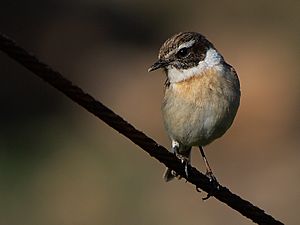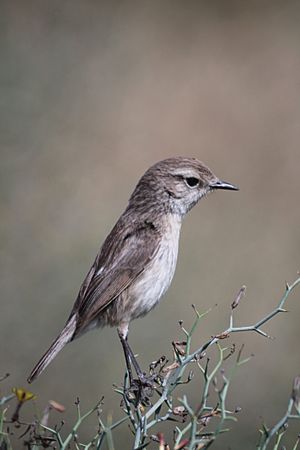Canary Islands stonechat facts for kids
Quick facts for kids Canary Islands stonechat |
|
|---|---|
 |
|
| Male on Fuerteventura, Canary Islands, Spain | |
| Conservation status | |
| Scientific classification |
The Canary Islands stonechat (Saxicola dacotiae) is a small bird that lives only on the island of Fuerteventura in the Canary Islands. It is also known as the Fuerteventura stonechat or Fuerteventura chat. On the island, people sometimes call it the Caldereta. This bird stays in one place and does not migrate.
Contents
About the Canary Islands Stonechat
What Kind of Bird Is It?
The Canary Islands stonechat is a type of passerine bird. Passerines are also known as songbirds. Scientists used to think it was part of the thrush family. But now, most agree it belongs to the Old World flycatcher family, Muscicapidae. Many small European birds like this are called chats.
This stonechat was once thought to be the same as the "common stonechat." However, it is quite different. It likely came from European stonechats that flew to the islands a very long time ago. This happened about 1 to 2 million years ago, during the Early Pleistocene period.
What Does It Look Like?
The Canary Islands stonechat looks a bit like a mix between the European stonechat and the whinchat. It is slender, similar to a European robin. Its upper body is dark brown with black streaks on its head and back.
It has a clear white stripe above its eye that goes past its eye. Its neck sides are also white. The bird's chest is a light orange-brown color, which gets lighter and paler towards its whitish tummy. Its rump and tail are dark. When it flies, you can see a white pattern on its tail. It also has a white band on its wings.
The female stonechat looks similar to the male, but her colors are not as bright. She has a brown head with black streaks and no white patches on her neck.
What Does It Sound Like?
The male Canary Islands stonechat makes a call that sounds like two pebbles tapping together. It also has a high, chirpy song, similar to the European stonechat.
Where It Lives and What It Does
Its Favorite Places
This stonechat really likes its home and tends to stay there. It mostly lives and nests in barrancos. These are rocky valleys and slopes. These areas have some open ground (about 30-50%) and small bushes.
Sometimes, they go into more open, dry areas like malpaís. These are old lava flows where plants have started to grow again. But the bird prefers small groups of palm trees and bushes. Some of the plants it likes are the aulaga (Launaea arborescens), the saltwort (Caroxylon vermiculatum), and the boxthorn (Lycium intricatum).
How It Finds Food
Male stonechats often sing from high spots. From these spots, they also like to catch insects while flying. Sometimes, they will go into fields or gardens to find food. They only seem to go into wide-open areas when they are gathering food for their babies.
Raising a Family
The female stonechat usually lays 4 to 5 eggs at a time. She sits on the eggs for about 13 days until they hatch. This bird often has two sets of babies each year.
Protecting the Canary Islands Stonechat
Why It's in Danger
The Canary Islands stonechat is now considered an endangered bird. This means it is at risk of disappearing forever. A big reason for this is new buildings, especially for tourism, which are taking over the bird's best homes.
It's hard to know exactly how many of these birds are left. But scientists think there are probably between 1,300 and 1,700 adult birds. Their numbers are going down. For example, a lot of land is being cleared on the Jandía peninsula. This is making the birds there isolated and more likely to be affected by having a small population.
Other Threats
The land becoming more like a desert also causes habitat loss. This is made worse by goats eating plants and by water levels going down in some areas. Wild cats and black rats also hunt the eggs and young birds.
What's Being Done
Since 1999, there has been a plan to help protect this species. Because these birds have a fairly high reproductive rate (meaning they can have many babies), they can survive if they have enough safe places to live and if predators are kept away.
The Chinijo Chat
There was once another type of stonechat called the Chinijo chat. It lived on the Chinijo Archipelago near Lanzarote. This subspecies became extinct in the early 1900s. People used to think it died out because its habitat got worse. However, it's more likely that introduced predators caused its extinction. This bird was only found on two small islands, Montaña Clara and Alegranza.
Images for kids
See also
 In Spanish: Tarabilla canaria para niños
In Spanish: Tarabilla canaria para niños




